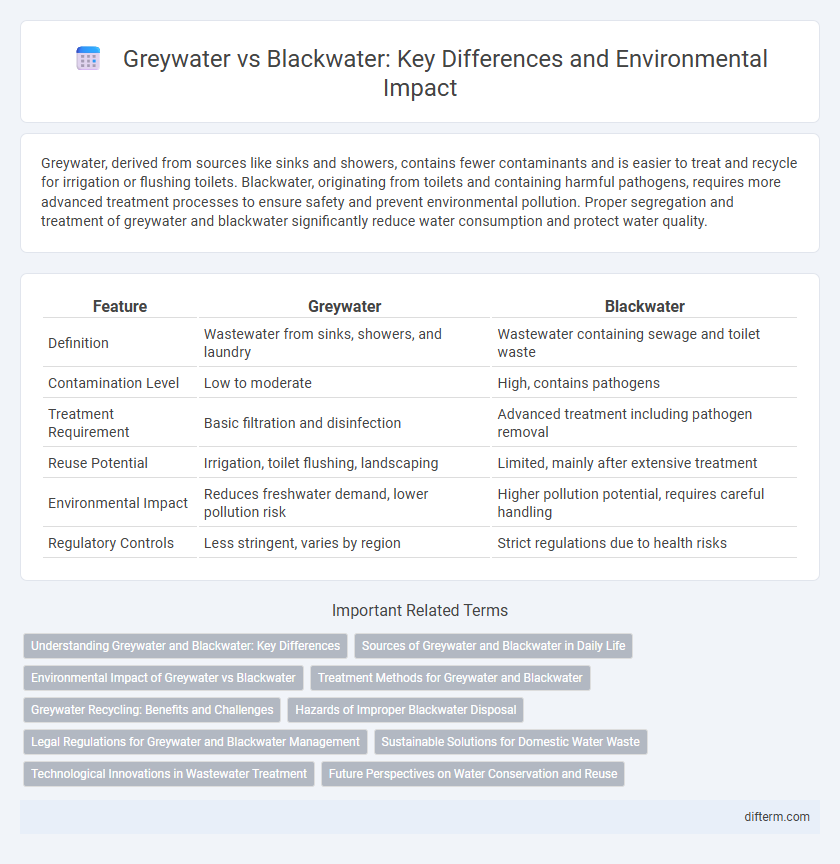Greywater, derived from sources like sinks and showers, contains fewer contaminants and is easier to treat and recycle for irrigation or flushing toilets. Blackwater, originating from toilets and containing harmful pathogens, requires more advanced treatment processes to ensure safety and prevent environmental pollution. Proper segregation and treatment of greywater and blackwater significantly reduce water consumption and protect water quality.
Table of Comparison
| Feature | Greywater | Blackwater |
|---|---|---|
| Definition | Wastewater from sinks, showers, and laundry | Wastewater containing sewage and toilet waste |
| Contamination Level | Low to moderate | High, contains pathogens |
| Treatment Requirement | Basic filtration and disinfection | Advanced treatment including pathogen removal |
| Reuse Potential | Irrigation, toilet flushing, landscaping | Limited, mainly after extensive treatment |
| Environmental Impact | Reduces freshwater demand, lower pollution risk | Higher pollution potential, requires careful handling |
| Regulatory Controls | Less stringent, varies by region | Strict regulations due to health risks |
Understanding Greywater and Blackwater: Key Differences
Greywater consists of gently used water from sinks, showers, and laundry, while blackwater contains sewage and wastewater from toilets. Greywater is less contaminated and can be treated for reuse in irrigation or toilet flushing, reducing freshwater consumption. Blackwater requires specialized treatment to safely manage pathogens and pollutants before environmental discharge or reuse.
Sources of Greywater and Blackwater in Daily Life
Greywater primarily originates from household sources such as sinks, showers, bathtubs, and laundry machines, containing relatively low levels of contaminants compared to blackwater. Blackwater encompasses wastewater from toilets and kitchen sinks, which includes human waste and food residues, posing higher risks of pathogens and pollutants. Understanding the distinct sources helps in implementing effective water recycling and treatment strategies for sustainable water management.
Environmental Impact of Greywater vs Blackwater
Greywater, which is wastewater from sinks, showers, and laundry, poses a lower environmental impact due to its reduced levels of contaminants and easier treatment processes compared to blackwater, which contains human waste and requires more energy-intensive treatment to prevent pollution. Using greywater for irrigation and non-potable applications conserves freshwater and reduces the burden on sewage treatment plants, decreasing nutrient runoff and water pollution. Blackwater treatment involves managing higher pathogen loads and chemical pollutants, leading to greater environmental risks if improperly handled.
Treatment Methods for Greywater and Blackwater
Greywater treatment primarily involves filtration, biological processes like constructed wetlands, and disinfection techniques such as chlorination or UV radiation to remove organic matter and pathogens for safe reuse in irrigation or flushing. Blackwater treatment requires more intensive processes, including septic systems, aerobic digestion, and advanced wastewater treatment plants that use activated sludge or membrane bioreactors to break down solids and remove harmful contaminants. Both treatment methods aim to protect public health and the environment by minimizing pollutant discharge and promoting sustainable water management.
Greywater Recycling: Benefits and Challenges
Greywater recycling significantly reduces freshwater consumption by reusing wastewater from showers, sinks, and laundry for irrigation and flushing toilets, promoting sustainable water management. It lowers the burden on sewage treatment plants and decreases environmental pollution by diverting greywater from blackwater systems. Challenges include the need for proper filtration to avoid health risks, regulatory compliance, and potential odor issues that require effective system maintenance.
Hazards of Improper Blackwater Disposal
Improper disposal of blackwater poses significant environmental hazards due to its high concentration of pathogens, organic waste, and toxic chemicals that contaminate soil and water bodies, leading to outbreaks of waterborne diseases like cholera and dysentery. Blackwater contains human waste and harmful microorganisms that, when released untreated, degrade ecosystems and threaten public health by polluting groundwater and surface water sources. Effective treatment and safe disposal of blackwater are critical to preventing the spread of contaminants and protecting both aquatic life and human communities.
Legal Regulations for Greywater and Blackwater Management
Legal regulations for greywater and blackwater management vary significantly, with greywater often subject to less stringent controls due to its lower contamination level, facilitating reuse in irrigation and non-potable applications. Blackwater, containing human waste, is heavily regulated under sanitation and wastewater treatment laws to prevent public health risks and environmental contamination. Compliance with local, state, and federal guidelines ensures safe handling, treatment, and disposal, with permits typically required for greywater reuse systems and mandatory treatment standards for blackwater discharge.
Sustainable Solutions for Domestic Water Waste
Greywater, sourced from baths, sinks, and washing machines, offers a sustainable solution for domestic water waste by enabling recycling for irrigation and flushing, significantly reducing freshwater consumption. Blackwater, containing organic waste and pathogens from toilets and kitchens, requires advanced treatment processes such as anaerobic digestion or membrane bioreactors to safely reclaim water and nutrients. Implementing greywater recycling systems alongside efficient blackwater treatment can optimize water reuse, lower environmental impact, and promote sustainable water management in households.
Technological Innovations in Wastewater Treatment
Technological innovations in wastewater treatment have advanced the differentiation and management of greywater and blackwater, enabling efficient recycling and reuse. Greywater, which constitutes approximately 50-80% of household wastewater, is treated using decentralized systems like membrane bioreactors and constructed wetlands to reduce contaminants and facilitate irrigation applications. Blackwater treatment integrates anaerobic digestion and advanced nutrient recovery technologies to mitigate pathogens and recover valuable resources such as biogas and phosphorus, promoting sustainable wastewater management.
Future Perspectives on Water Conservation and Reuse
Innovations in greywater recycling systems offer significant potential to reduce freshwater demand by reusing lightly contaminated household water for irrigation and flushing. Advances in treatment technologies are making greywater safer and more accessible, promoting widespread adoption in urban and arid regions. Future strategies emphasize integrating greywater reuse into smart water management frameworks to enhance sustainability and resilience against water scarcity.
greywater vs blackwater Infographic

 difterm.com
difterm.com